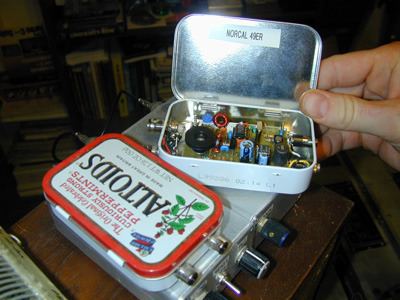 | ||
In amateur radio, QRP operation refers to transmitting at reduced power while attempting to maximize one's effective range. The term QRP derives from the standard Q code used in radio communications, where "QRP" and "QRP?" are used to request, "Reduce power", and ask "Should I reduce power?" respectively. The opposite of QRP is QRO, or high-power operation.
Contents
Philosophy
Most amateur transceivers are capable of transmitting approximately 100 watts, but in some parts of the world, such as the U.S., amateurs can transmit up to 1,500 watts. QRP enthusiasts contend that this is not always necessary, and doing so wastes power, increases the likelihood of causing interference to nearby televisions, radios, and telephones and, for United States' amateurs, is incompatible with FCC Part 97 rule, which states that one must use "the minimum power necessary to carry out the desired communications".
The current record for a QRP connection is 1 µW for 2640 kilometers (1650 miles) on 10-meter band (28-29.7 MHz).
Practice
There is not complete agreement on what constitutes QRP power. Most amateur organizations agree that for CW, AM, FM, and data modes, the transmitter output power should be 5 watts (or less). The maximum output power for SSB (single sideband) is not always agreed upon. Some believe that the power should be no more than 10 watts peak envelope power (PEP), while others strongly hold that the power limit should be 5 watts. QRPers are known to use even less than five watts, sometimes operating with as little as 100 milliwatts or even less. Extremely low power—1 watt and below—is often referred to by hobbyists as QRPp.
Communicating using QRP can be difficult since the QRPer must face the same challenges of radio propagation faced by amateurs using higher power levels, but with the inherent disadvantages associated with having a weaker signal on the receiving end, all other things being equal. QRP aficionados try to make up for this through more efficient antenna systems and enhanced operating skills.
QRP is especially popular with CW operators and those using the newer digital modes. PSK31 is a highly efficient, narrow-band mode that is very suitable to QRP operation.
QRSS
QRSS refers to transmitting extremely slowly. Some extreme QRP enthusiasts use QRSS to compensate for the decreased signal-to-noise ratio involved in QRP operation. QRSS derives from the standard Q code used in radio communications, where "QRS?" asks "Shall I send more slowly?" and "QRS" requests "Send more slowly".
Rather than directly listening to such slow transmissions, many QRSS enthusiasts record the transmission for later analysis, later decoding "by ear" while playing it back at much faster rates (time compression), or decoding "by eye" on the waterfall display of a spectrum analyzer.
QRSS enthusiasts typically use some form of Morse code, except much slower—rather than a typical 1⁄10 second "dit" time, QRSS transmissions may use a full second for the "dit" time, or in extreme cases, a full minute for a single "dit" time.
A few people apply QRSS techniques to other narrow-band communication codes or protocols, such as the "Slowfeld" variant of Hellschreiber, slow-scan television, MT63, etc.
Equipment
Many of the larger, more powerful commercial transceivers permit the operator to lower their output level to QRP levels. Commercial transceivers specially designed to operate at or near QRP power levels have been commercially available since the late 1960s. In 1969, American manufacturer, Ten-Tec, produced the Powermite-1. This radio was one of Ten-Tec's first assembled transceivers. (The MR-1 was available, and it was essentially the same radio, albeit in kit form.) This radio featured modular construction (all stages of the transceiver were on individual circuit boards): the transmitter was capable of about one or two watts of RF, and the receiver was a direct-conversion unit, similar to that found in the Heathkit HW-7 and HW-8 lines. Many amateurs became quite adept at QRP'ing through their use of these early, trend-setting radios. As QRP has become more popular in recent years, radio manufacturers have introduced radios specifically intended for the QRP enthusiast. Popular US models include Elecraft KX3, K2 and K1, the Yaesu Yaesu FT-817, the Icom IC-703, and the 516 Argonaut V and the new 539 Argonaut VI from TenTec. Another popular source is Hendricks QRP Kits, which offers a variety of popular kits. Enthusiasts operate QRP radios on the HF bands in portable modes, usually carrying the radios in backpacks, with whip antennas. Some QRPers prefer to construct their equipment from kits or homebrew it from scratch. Many popular designs are based on the NE612 mixer IC, i.e. the K1, K2, ATS series and the Softrock SDR.
Contests and awards
There are specific operating awards, contests, clubs, and conventions devoted to QRP enthusiasts.
In the United States, the November Sweepstakes, June and September VHF QSO Parties, January VHF Sweepstakes, and the ARRL International DX Contest, as well as many major international contests have designated special QRP categories. For example, during the annual ARRL's Field Day contest, making a QSO (ham-to-ham contact) using "QRP battery power" is worth five times as many points as a contact made by conventional means.
The QRP ARCI club sponsors 12 contests during the year specifically for QRP operators. QRP-ARCI Contests
Typical awards include the QRP ARCI club's "thousand-miles-per-watt" award, available to anyone presenting evidence of a qualifying contact. QRP ARCI also offers special awards for achieving the ARRL's Worked All States, Worked All Continents, and DX Century Club awards under QRP conditions. Other QRP clubs also offer similar versions of these awards, as well as general QRP operating achievement awards.
